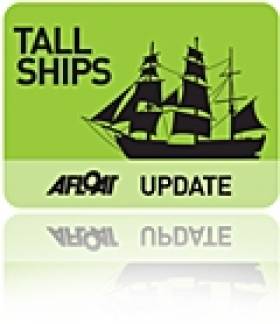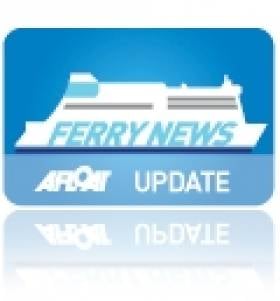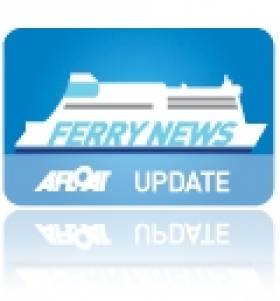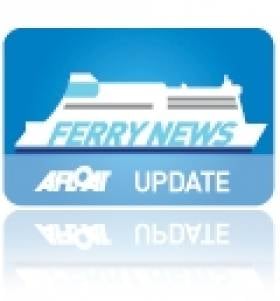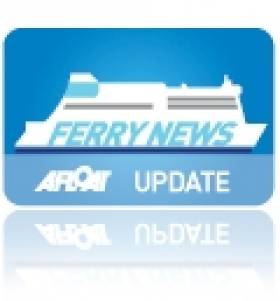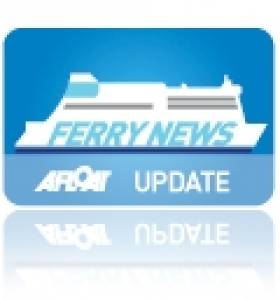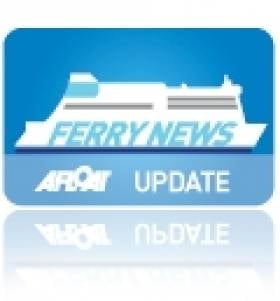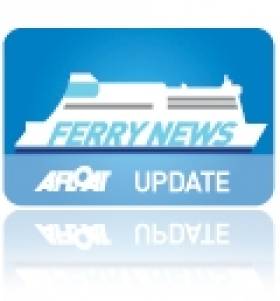Displaying items by tag: DublinLiverpool
Tall Ships Voyage Package to Launch Sea Sail Cities 2
#VoyagePackage - Sail Training Ireland in association with Poolbeg Yacht & Boat Club in Ringsend, Dublin Port, are offering a special package of benefits including memberships and a voyage.
To celebrate the launch of this initiative two tall ships 'Maybe' and 'Spirit of Oysterhaven' will be in Poolbeg on April 26th and open to visitors.
New members will be invited to join current members at a reception in Poolbeg to visit the ketches, relax and enjoy music, refreshments and finger food.
The voyage available as part of the package (€200) is on board Maybe, a Dutch ketch dating from 1929, which over a four day period (April 27-30) is to sail from Dublin to Liverpool.
The aim is to develop a group of enthusiastic tall ship sailors that take part in regular club sailing and racing as well as collectively organising Tall Ship voyages and activities each year (with our help).
This is a unique opportunity to experience Tall Ship Voyages, and become part of a regular community of sailors in the heart of Dublin City.
For details of the Sail Training Ireland /PYBC offer, age group and application forms click here. Noting, the offer is only open until 20th April.
Precision Timing as Freight Newbuild Completes Quartet
#FINAL FREIGHT-FERRY – Seatruck Precision has become the final newbuild of a quartet of ro-ro freight-only ferries to enter Irish Sea service for Seatruck Ferries, writes Jehan Ashmore.
The 18,920 tonnes newbuild completed her maiden 'commercial' round-trip, departing Liverpool on Tuesday and returning overnight from Dublin with an arrival on Merseyside early yesterday morning.
She was built by Flensburger Schiffbau-Gesellschaft (FGS), Germany along with her sisters with each having a freight capacity of 2,166 lane metres spread over four decks, carrying 151 (un-accompanied) trailer units. An increase of 36 trailers compared to the quartet of older 'P' class ships.
The FGS quartet are called the 'Heyham'-max series, as they are the largest-ever vessels designed to use the tight confines of the Lancashire port. It is believed that the latest newbuild will be deployed out of the port joining Seatruck Performance, the third newbuild of the series which runs on the route to Dublin.
The remaining pair, Seatruck Power and leadship of the series Seatruck Progress operate on the Dublin-Liverpool route. However as the latter vessel is currently moored at Cammell Laird shiprepair facility in Birkenhead, the newbuild is deputising in her place on the central corridor route.
Seatruck also operate Heysham-Warrenpoint and in May a new route Heysham-Belfast began service.
Ferry For Falmouth
#FERRY NEWS – European Endeavour (2000/ 24,046grt), the largest of three ferries running for P&O's Dublin-Liverpool route departed from the capital's port this afternoon bound for A&P Groups dry-dock facility in Falmouth, writes Jehan Ashmore.
The former Dover-Calais serving ferry started working on the Irish Sea on a full-time basis last year as previously reported. Her fleetmates are the 17,000 tonnes sisters Norbank and Norbay.
The trio of ro-pax ferries are to a design where freight is predominately the main cargo and passenger capacity is reduced considerably compared to most conventional ferries. European Endeavour can handle 130 lorries and accommodate 210 passengers whereas her fleetmates are the reverse with greater freight capacity for 150 freight units and a reduced capacity for 114 passengers.
P&O are the only ferry firm on the route providing passenger and car ferry service though they do not cater for 'foot' passengers. Their rivals Seatruck Ferries offer the only dedicated freight-operation on a network of routes on the north Irish Sea including the Liffey-Mersey link, where in recent months new tonnage has entered service.
Summer Debut for Final Seatruck Newbuild
#FERRY NEWS – The final of the quartet of new ro-ro freight vessels, Seatruck Precision was launched last week from the FSG Flensburg Yard, Germany, according to the Irish Trucker.
The compact and energy-efficient vessel, which has a capacity of up to 151 trailers was named by Mrs Lynn McBurney, wife of Seatruck customer Norman McBurney, founder of McBurney Transport - one of Ireland's largest independent haulage companies.
Seatruck Precision in June will join her three sisters on Seatruck's unaccompanied freight routes across the Irish Sea. The first newbuilding, Seatruck Progress (click HERE) operates on the Dublin-Liverpool – route. The second newbuild, Seatruck Power, joined the central corridor route in February while the third newcomer, Seatruck Performance which was launched in January, is to start operating in the Irish Sea next month.
Sister Powers On to Liverpool Route
#FREIGHT FERRY NEWS- Seatruck Power (2011/19,722grt) made her debut on the Dublin-Liverpool route last week, bringing an additional boost to freight capacity and follows her sister which only entered service in December, writes Jehan Ashmore.
The newbuild joins the leadship Seatruck Progress (see related report) on the central corridor service and another pair are due for completion by mid-year and are to be deployed on Seatruck's other Irish Sea routes.
The quartet, were all ordered from the Flensburger Schiffbau-Gesellschaft (FSG) yard in Germany. At 142m long, each of the 150-unit capacity newbuilds carry an additional 35 units compared to the 'P' class vessels, in which two of these vessels have been replaced from the Liverpool route.
Each sister has space for 2,166 lane freight metres spread across four decks, where on this particular deck hazardous and refrigerated cargo can be handled. They are also designed to carry rolling project cargo and heavy-lift items.
Another Good Performance From Seatruck
#FREIGHT FERRY - The third of four newbuilds, Seatruck Performance was launched at the FGS Flensburg Yard, Germany, last week, according to The Motorship.
The first of the newbuildings, Seatruck Progress, is now operating on the Dublin-Liverpool route. The second in the series, Seatruck Power, will join this route in mid-February (see previous report HERE). The third vessel, Seatruck Performance, will begin operations in the Irish Sea in April and the final ferry will be launched at FSG at the end of March and is due to enter service in June.
All four ships will operate mainly in the Irish Sea. They are 142m long and 25m wide, boast a freight-carrying capacity of 2,166 lane-metres on four decks and can carry up to 155 trailers.
The FSG ships are the most efficient and modern in the Seatruck fleet, and will be the biggest to operate out of the port of Heysham, the length being determined by the size of this port.
FSG engineers designed the ships for eco-friendliness and low fuel consumption. Compared to conventional ships, they are said to consume up to 30% less fuel, saving costs and representing a significant contribution to environmental protection.
Seatruck Newbuild Making Progress On Irish Sea
#FERRY NEWS -Seatruck Ferries newbuild freight-only ferry, Seatruck Progress carried out berthing trials in Dublin Port yesterday in preparation to her debut on the Liverpool route over the festive period, writes Jehan Ashmore.
This was the inaugural call to the capital, though she had sailed across Dublin Bay earlier this month (as previously reported - click HERE) during her delivery voyage to Liverpool from German shipbuilders FGS Flensburger.
At 142 metres long and with a beam of 24 metres, the four decked ro-ro vessel, offers more capacity to the routes existing pair of 'Point' class vessels, as she can handle an extra 35 trailer units (each of 13.5m) than the Clipper Point and Clipper Pennant.
In February, the newcomer's second sister out of four on order, Seatruck Power is set to join her on the central corridor route.
Seatruck are the only Irish Sea operator dedicated to the carriage of un-accompanied freight traffic, though the vessels can cater for driver accompanied units with a limited number of cabins.
Seatruck Newbuild Makes a Fleeting Appearance
#FERRY NEWS-Seatruck Progress (5,300 dwt) the new freight-only ro-ro, due to enter Seatruck Ferries Dublin-Liverpool service this month, as previously reported on Afloat.ie, sailed past Dublin Bay on Tuesday. She continued her overnight delivery voyage to arrive in Liverpool yesterday, fresh from German builders, FGS Flensburg, writes Jehan Ashmore.
As the newbuild approached Dublin Bay, she set a course to the east of the Burford Bank buoys where she continued her voyage to Liverpool, entering the Bootle docks through Langton Lock.
The Douglas registered ro-ro is to be joined by her fleetmate, Seatruck Power on the central corridor service next February. Each of the 21-knot quartet measure 142m long, have a beam of 24m and cater for 2,166 lane freight-metres with the use of an added upper fourth deck.
The increased capacity will enable un-accompanied trailer units to reach 70 on each of the sailings, which are currently served by smaller 'P' series ro-ro's Clipper Point and Clipper Pennant. These vessels were also commissioned by Seatruck from Spanish shipyards and entered servvice several years ago.
Seatruck which is a subsidiary of the Danish-owned Clipper Group, is set to expand the fleet as the Irish Sea's only freight-only operator with a futher pair of the same class from FGS, which are due for delivery in the first-half of 2012. According to Seatruck, these newbuilds are likely to be deployed on the company's other Irish Sea routes.
Seatruck's New Freight-Ferry on Delivery Voyage
#FERRY NEWS-Seatruck Progress (photo), the first of two 18,900 gross tonnes ro-ro newbuilds due to enter on Seatruck Ferries Dublin-Liverpool route, is en -route in the English Channel today from German builders, FGS Flensburg, writes Jehan Ashmore.
Her sister Seatruck Power is due to join her fleetmate on the central corridor service by mid-February. In addition Seatruck have on order another pair of the same class from FGS which are to be completed in 2012 and are likely to be deployed on the company's other Irish Sea routes.
The new quartet each measure 142m and will offer 2,166 lane freight-metres spread over four decks. They will each have a capacity of 150 units, 35 more than Seatruck's current P Series vessels in which Clipper Point and Clipper Pennant are currently employed on the route.
The company operate 80 sailings per week on four routes: Dublin-Liverpool,Dublin- Heysham, Warrenpoint-Heysham and Larne-Heysham. The newbuilds will also be the largest vessels ever to operate out of Heysham.
In the last two years freight volumes doubled and Seatruck has 20% of the Irish Sea market as against 3.7% in 2004. This year Seatruck will ship 300,000 units on the Irish Sea and with the fleet expansion this total will grow substantially in 2012.
Seatruck’s New Freight-Ferry to Make December Debut
Seatruck, which claims 20% of the Irish Sea market compared to just 3.7% in 2004, says it will transport 300,000 units in 2011 on its four routes: Dublin-Liverpool, Dublin-Heysham, Warrenpoint-Heysham and Larne-Larne. With the introduction of the newer larger vessels, Seatruck is aiming at the 45% of Irish Sea freight market that is still driver-accompanied.
Alistair Eagles, MD of Seatruck (Irish Sea) says that his company's share of unaccompanied freight volumes is set to grow in 2012, although the total Irish Sea ro-ro market is set to remain static next year, but better than a 1% decline in 2011.
Mr Eagles said: "We believe that our sector of the market — freight-only unaccompanied — will continue to grow. By offering pure freight services we can keep the costs down relatively lower compared with the combined passenger and freight ferry operators.
"We are seeing a switch away from driver-accompanied shipments because hauliers can save quite a lot of money."
Seatruck also benefited from a radical shake-up on the Irish Sea ferry market, with largescale withdrawals of capacity by DFDS and other changes, notably taking over the Dublin-Heysham route in February, to read more click HERE. The route is served by the chartered 120-unit Anglia Seaways which has accommodation for 12 drivers.
As for the remaining newbuild pair, they are scheduled for delivery from FGS during the first half of 2012 and deployed on yet-to-be announced routes. Like the new quartet, the same number were ordered of the 'P' class which entered service from 2008 onwards which included Clipper Pace and Clipper Panorama which currently operate 22 weekly sailings on the Warrenpoint-Heysham route.
Seatruck also operate Clipper Ranger and Arrow on Larne-Heysham sailings, where they each provide a capacity of 65 units and offer driver accompanied traffic with accommodation in en-suite cabins.


























